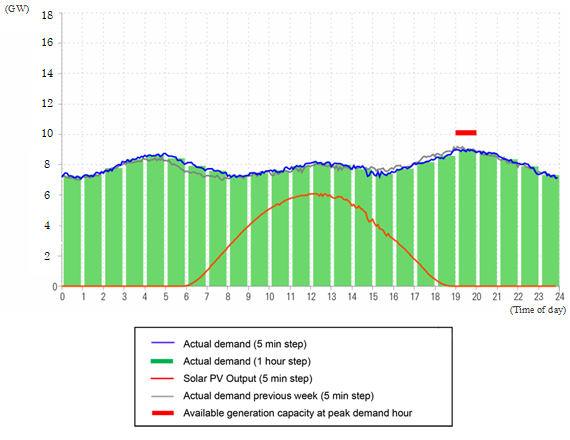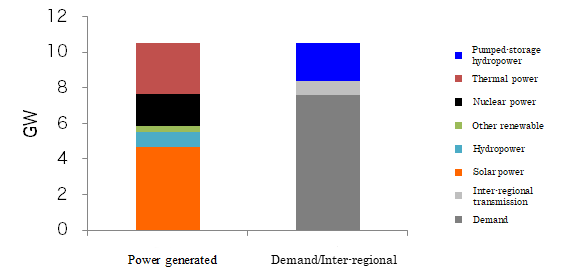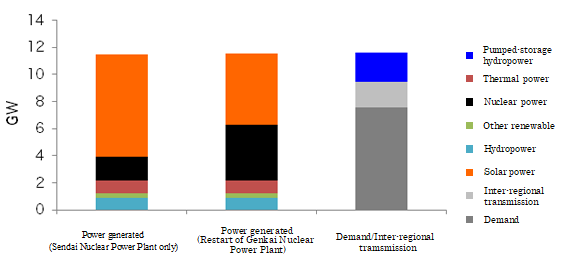Renewables Update
Solar covered 76% of a demand in Kyushu at its peak generation
(Japanese original published on 12 June 2017)
Keiji Kimura, Senior Researcher, Renewable Energy Institute
Tatsuya Wakeyama, Senior Researcher, Renewable Energy Institute
Kyushu is an area with the largest growth of solar PV deployment in Japan. Hence, it was widely feared that solar power curtailment, already implemented in some remote islands, will be imposed this year in mainland Kyushu as well. However, it appears that Kyushu Electric Power Co., Inc. was able to endure through April and May 2017 without implementing any solar power curtailment. The spring holidays are considered a period in which electricity demand decreases in particular, with little demand for heating and cooling. At the same time, it is a period when solar PV output particularly rises under favorable weather conditions, given the strong solar radiation. Kyushu Electric Power has announced that solar power output at 1:00 pm on 23 April covered 76% of demand in its service area (Fig. 1). The maximum output of solar power on 23 April was 6.07 GW, while electricity demand in Kyushu Electric Power service area was 7.98 GW.

Source: ‘Electricity Forecast’ by Kyushu Electric Power
Note: At the time this document was prepared, Kyushu Electric Power had not announced information on the state of supply from power sources other than solar power.
What measures did Kyushu Electric Power apply this time to balance demand and supply? As Information on the state of supply by power resource is released quarterly, the information was not available at the time this document was prepared. It may be useful to refer to the performance last year. The electricity demand at 12:00 on 4 May 2016 (Greenery Day) was approximately 7.58 GW in the Kyushu Electric Power service area. At that time, output from solar PV was 4.65 GW, or 61% of the area demand (Fig. 2). Combined with the output from nuclear and other renewable sources, the area demand at this time was largely satisfied. A further 2.9 GW was generated from thermal power plants, so the area demand of electricity was exceeded by 2.95 GW. The overloaded electricity of 2.16 GW was consumed through pumped-storage hydropower generation, pumping up water to use the excess electricity. Furthermore, approximately 0.8 GW was transmitted as planned, to the Chugoku Electric Power service area through the Kanmon Interconnection, thus achieving the balance between demand and supply. This example illustrates the status of power supply/demand within the Kyushu Electric Power service area, and the way the utility maintains demand-supply balances through pumped-storage hydropower and inter-regional transmission. It can be surmised that similar operation was applied during the spring of 2017.

Source: ‘Grid Information’ by Kyushu Electric Power
Now what are the probabilities of curtailment arising within the Kyushu Electric Power service area in the future? In fact, the restart of the Genkai Nuclear Power Plant seems to be the key. The Kyushu Electric Power service area can accommodate power generation beyond the area demand up to 4 GW through maximum use of inter-regional transmission and pumped-storage hydropower. For this reason, assuming demand for electricity of (approximately) 7.6 GW based on the figure from 4 May last year, total output from power generation must be adjusted to a level not exceeding 11.6 GW. It is thought that by keeping thermal power generation to a minimum on the power generation side it could be reduced to 0.92 GW (Working Group for Grid). Combination of this figure with those for hydropower and other renewable energy sources gives a total of 2.14 GW, with 9.47 GW remaining.

Source: ‘Grid Information’ by Kyushu Electric Power
If Sendai Nuclear Power Plant (total output 1.78 GW) were the only nuclear power plant in operation, curtailment would not be necessary unless solar output became 7.7 GW or more. However, should the reactors nos. 3 and 4 at the Genkai Nuclear Power Plant get restarted, which is planned for this fall or thereabouts, the total nuclear power output will be 4.14 GW, indicating that curtailment would be necessary if solar power output were to total roughly 5.3 GW or more. That is, if solar output is forecasted to be 6.07 GW or more, equivalent to 23 April 2017, then curtailment would be implemented, once the Genkai Nuclear Power Plant resumes. Thus it is expected that curtailment would be applied to renewable energy, not owing to the development of renewable energy but to the restart of nuclear power generation, starting in the autumn of 2017.
It is important to balance supply and demand in the grid. In that sense, renewable energy can contribute to adjusting the demand-supply balance through curtailment. On the other hand, nuclear power, unable to deliver any flexibility, seems to be one of the major problems from the grid management point of view.






